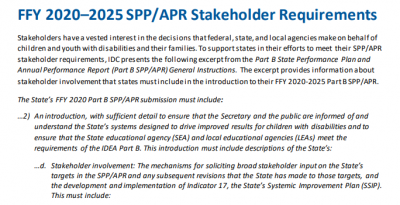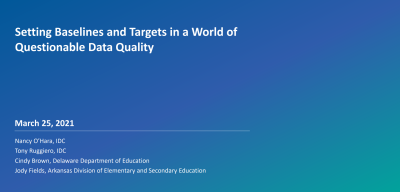Site Search
Results 29 - 35 of 47
-
Developing Your Stakeholder Engagement Plan for the New SPP/APR Package
This webinar provided an overview of the expanded stakeholder engagement requirements for the FFY 2020–2025 SPP/APRs. Presenters shared strategies for organizing and involving stakeholders in the development and implementation of their SPP/APRs. Webinar participants shared their ideas and approaches for developing a stakeholder engagement plan. Throughout the presentation, IDC staff highlighted helpful resources to support meaningfully involving stakeholders in decision making.
-
Setting Baselines and Targets in a World of Questionable Data Quality
All states are developing a new SPP/APR. They may consider new baselines, as appropriate, and must set targets for results indicators. This baseline and target setting will be complicated because states collected and reported the most recent SPP/APR data available during the COVID-19 school closures, which affected the completeness, accuracy, and quality of the data. With these issues in mind, IDC presenters shared considerations for determining baselines and strategies states may use to set targets for SPP/APR indicators. Two states took a dive into several SPP/APR indicators to share their plans for setting baselines and targets and engaging their stakeholders in the process.
-
Tips for Success: Writing an Effective FFY 2020 State Performance Plan/Annual Performance Report
IDC staff guided states through writing a comprehensive and accurate FFY 2020 State Performance Plan/Annual Performance Report (SPP/APR), including Indicator 17 (State Systemic Improvement Plan). Presenters highlighted OSEP guidance, shared key points to keep in mind while writing, and provided examples of common writing and reporting challenges and potential solutions. Webinar participants shared their ideas and approaches to writing their reports.
Format: Guides and Briefs
FFY 2020–25 Part B SPP/APR Changes at a GlanceThe FFY 2020–25 Part B SPP/APR Changes at a Glance resource is a quick overview for tracking updates to indicators in the new FFY 2020–25 SPP/APR package. For each of the 17 SPP/APR indicators, the table denotes whether there will be no changes, minor changes and/or clarifications, changes to response rates and representativeness, changes to data sources, and new components.
Format: Quick Reference
Templates for Part B SPP/APR Stakeholder Involvement and Target SettingStates can use the Organizer Template for Part B SPP/APR Target Setting to briefly document information for consideration when setting new SPP/APR targets for all indicators in the FFYs 2020–25 SPP/APR collection. States can supplement this overview template with the Indicator Organizer for Part B SPP/APR Stakeholder Involvement and Target Setting, which is designed to capture more detailed information on stakeholder involvement in setting targets for individual SPP/APR indicators.
Format: Quick Reference
FFY 2020-2025 SPP/APR Stakeholder RequirementsThe FFY 2020-2025 SPP/APR shares the stakeholder requirements for the FFY 2020-2025 SPP/APR in a simple one page format. This resource can be used with state staff and other partners when planning for the SPP/APR.
Format: Guides and Briefs
Parent Involvement Data: How to Measure and Improve Representativeness for Indicator B8This interactive resource provides states with an overview on how to gather representative parent involvement data for Part B SPP/APR Indicator 8. The resource defines key concepts such as representativeness, sampling, nonresponse bias, response rates, and weighting. It also offers information on how to improve the quality of parent involvement data, including strategies that can help states collect representative data and evaluate and improve the representativeness of their data before, during, and after data collection.








